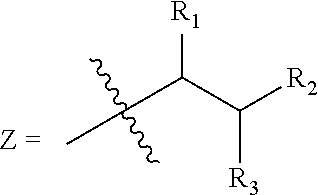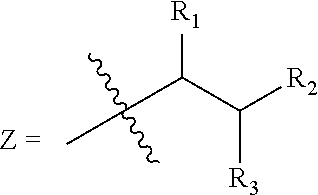Trialkyl cationic lipids and methods of use thereof
a technology of which is applied in the field of trialkyl cationic lipids and lipid particles, can solve the problems of reduced activity of the construct, reduced the ability to gain access to the intracellular compartment, and susceptibility to nuclease digestion in plasma
- Summary
- Abstract
- Description
- Claims
- Application Information
AI Technical Summary
Benefits of technology
Problems solved by technology
Method used
Image
Examples
example 1
[0423]This Example describes the synthesis of exemplary, trialkyl, cationic lipids of the present invention.
Synthetic Scheme for Compound 9
[0424]
Synthesis of Compound 2
[0425]
[0426]To a cooled solution (0° C.) of (Z)-dec-4-en-1-ol 9 (20 g, 128.0 mmol) and triethylamine (26.7 mL, 191.9 mmol) in anhydrous dichloromethane (200 mL) was slowly added methane sulfonyl chloride (14.9 mL, 191.9 mmol). The solution was stirred for 30 min at room temperature then diluted with dichloromethane (100 mL). The solution was washed with saturated sodium bicarbonate (3×150 mL) and then the combined aqueous washes were extracted with dichloromethane (150 mL). The combined dichloromethane extracts were dried on magnesium sulfate, filtered and concentrated in vacuo to dryness. The residue was filtered through a pad of silica (100% dichloromethane) to afford (Z)-dec-4-enyl methanesulfonate 2 as a yellow oil (28.5 g, 95%). Rf 0.5 (100% CH2Cl2).
Synthesis of Compound 3
[0427]
[0428]To a solution of (Z)-dec-4-en...
example 2
[0536]This Example compares the effectiveness, in a murine ApoB siRNA activity model, of short chain trialkyl lipids of the present invention with lipids having longer alkyl chains but which are otherwise structurally identical to the short chain trialkyl lipids.
[0537]Nucleic acid-lipid particle formulations containing cationic lipids were assessed for their ability to knockdown ApoB expression in the livers of 7 to 9 week old female BALB / c mice. Mice were dosed intravenously (tail vein) in groups of three at either 0.02, 0.03 or 0.05 mg / kg. ApoB knockdown (normalized to the housekeeping gene GAPDH) was measured relative to PBS as a negative control. Each experiment was terminated at 48 hours after dosing.
[0538]For comparison to a positive control, the performance of short chain trialkyl lipids of the present invention was compared to a potent cationic lipid, referred to as C2K, that is known to facilitate nucleic acid delivery, in vivo, in nucleic acid-lipid particles (Nature Biote...
example 3
[0549]Further experiments in the murine ApoB model used a different cationic lipid as the positive control; DLin-MP-DMA. DLin-MP-DMA is described in patent application WO 2011 / 141705, and has the structure:
[0550]
[0551]As shown in Table 5, in the same murine ApoB model, DLin-MP-DMA was shown to be more effective than C2K in three separate experiments, and is therefore a valid positive control:
[0552]
TABLE 5Comparison between C2K and Dlin-MP-DMA as Positive ControlsApoB gene silencingrelative to PBS control(Liver ApoB:GAPDsiRNA DoseCompoundmRNA ratio)Experiment 10.03 mg / kgC2K−51%DLin-MP-DMA−69%Experiment 20.05 mg / kgC2K−59%DLin-MP-DMA−65%Experiment 30.03 mg / kgC2K−54%DLin-MP-DMA−62%
[0553]In another experiment, two more lipids of the present invention (Compounds 62 and 71) were formulated into lipid nanoparticles with siRNA to target ApoB. Mice were dosed intravenously (tail vein) and sacrificed 48 h after dosing. Livers were harvested and homogenized, and the level of ApoB silencing (nor...
PUM
| Property | Measurement | Unit |
|---|---|---|
| mol % | aaaaa | aaaaa |
| mol % | aaaaa | aaaaa |
| mol % | aaaaa | aaaaa |
Abstract
Description
Claims
Application Information
 Login to View More
Login to View More - R&D
- Intellectual Property
- Life Sciences
- Materials
- Tech Scout
- Unparalleled Data Quality
- Higher Quality Content
- 60% Fewer Hallucinations
Browse by: Latest US Patents, China's latest patents, Technical Efficacy Thesaurus, Application Domain, Technology Topic, Popular Technical Reports.
© 2025 PatSnap. All rights reserved.Legal|Privacy policy|Modern Slavery Act Transparency Statement|Sitemap|About US| Contact US: help@patsnap.com



